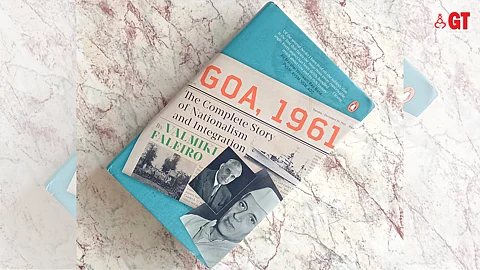

Book title: Goa, 1961
Author: Valmiki Faleiro
Publisher: Vintage an imprint of Penguin Random House
There are plenty of books on Goa’s liberation, spanning from recorded facts to personal memoirs. They give an account of Operation Vijay and the preceding events. Until now, they have been the books to refer to for any data on that period.
Faleiro describes in detail how Operation Vijay progressed. It is, perhaps, the most detailed description of the operation to liberate Goa and the events leading up to it. It, perhaps, even answers the question that in recent times has been asked quite frequently – why was the liberation of Goa delayed? Well, you won’t get the answer in this review. I leave it to the readers to find it themselves by leafing through the book.
But now comes Valmiki Faleiro with Goa, 1961, a tome that delves deep into the liberation movement, and gives an authoritative narrative of the period, having sourced facts from a variety of books and papers.
On a perusal of the book, one would imagine that Faleiro has left no source unearthed to write this book, and, as the subtitle says, it indeed is the complete story of nationalism and integration.
Faleiro describes in detail how Operation Vijay progressed. It is, perhaps, the most detailed description of the operation to liberate Goa and the events leading up to it.
It, perhaps, even answers the question that in recent times has been asked quite frequently – why was the liberation of Goa delayed? Well, you won’t get the answer in this review. I leave it to the readers to find it themselves by leafing through the book.
But Goa, 1961 has some interesting facts that are worth extracting in brief and reproducing here. For instance, Faleiro shows that Operation Vijay was not a decision that the Indian government took hurriedly or unexpectedly.
The date for the operation may have been decided almost overnight, but the plan to use military force to liberate Goa was formulated well in advance.
According to Faleiro, “India had decided to use force to evict the Portuguese from Goa, Daman and Diu towards the end of August 1961. In early October 1961, the Indian Army’s Southern Command began preparing a plan for the invasion. By 10 November 1961, the plan was ready.” So, it was over a month later that the plan was actually operationalised.
“Senior officers of the small garrison defending Panjim were in a hopeless situation without human or material means to resist the Indian troops, artillery, armour or the air force. Archbishop D. José Vieira Alvernaz was able to convince the CO to lay down arms and declare a ceasefire, saving Panjim and its inhabitants. The Portuguese hoisted a white flag atop a riverfront tree on the southern bank of the Mandovi River. Past dusk, closer to 8 p.m., Goan priest Msgr Gregório Magno de Souza Antão, carried a ceasefire letter from Maj. Acácio Nunes Tenreiro, military commander of Panjim, in a rowboat across the Mandovi.”
Valmiki Faleiro, Goa, 1961
Even the period it would take to complete the operation had been foreseen. On October 24, 1961, then Prime Minister Pandit Jawaharlal Nehru met the GOC-in-C Southern Command, seeking to know the time the operation would take.
The reply was “three days in the event of Portuguese resistance and a considerably shorter period in the event of no resistance or of qualified resistance.”
When the operation was put in motion, it was the latter, and here is what Faleiro says of how Panjim, the capital, was taken: “Senior officers of the small garrison defending Panjim were in a hopeless situation without human or material means to resist the Indian troops, artillery, armour or the air force. Archbishop D. José Vieira Alvernaz was able to convince the CO to lay down arms and declare a ceasefire, saving Panjim and its inhabitants. The Portuguese hoisted a white flag atop a riverfront tree on the southern bank of the Mandovi River. Past dusk, closer to 8 p.m., Goan priest Msgr Gregório Magno de Souza Antão, carried a ceasefire letter from Maj. Acácio Nunes Tenreiro, military commander of Panjim, in a rowboat across the Mandovi.”
This is all history, but Faleiro has been meticulous and has managed to put it in an easy-to-read narrative form that makes it a page-turner.
The book also has an annexure of Goan Catholic freedom fighters, which includes those who did not seek registration or are not registered freedom fighters. So, while there are 116 of them registered, Faleiro lists 209, and even that list is not exhaustive.
"The Goan is reduced to a minority in his own land. Goa may, a few decades into the future, remain only in name.”
Valmiki Faleiro, Goa, 1961
For those interested in the history of Goa, this book is an important addition to their personal libraries.
The book also brings into perspective the changing Goa, and in the epilogue, Faleiro makes an interesting statement when he says, “The Goan is reduced to a minority in his own land. Goa may, a few decades into the future, remain only in name.”
With the question of Goan identity being debated quite regularly in the state, this book may also give us a view of how this change has been coming about, for liberation changed Goa.
It not only empowered the Goan in various ways, it also brought in development that changed the face of the land.
The book ends with the integration of Goa into India, and we do need another that is as meticulously researched and which will chronicle the period post-1961. Wonder if Valmiki Faleiro would be up to it.